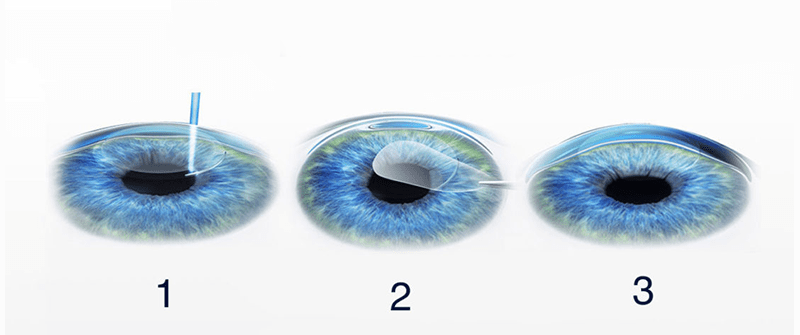ReLEx Smile Eye Surgery In Delhi
Smile: Laser Vision Correction Surgery

Why SMILE?
SMILE, also known as Small Incision Lenticule Extraction is a laser vision correction surgery that was introduced in the year 2012. It’s hard to deny that in the field of eye-care, technical advancements are taking place continuously. For this refractive surgery, the surgeon uses the femtosecond laser. The laser can cut a small tissue, known as lenticule. Through another incision, the surgeon can dissect and extract the lenticule. Once the lenticule gets removed, the cornea can be reshaped. However, the lenticule can also be removed through blade-free vision correction process. Through this treatment, patients can easily get rid of their glasses and contact lenses.
Conditions
SMILE surgery can treat refractive vision error like Myopia or Nearsightedness. The result of this surgery is simply outstanding.
More than 750 surgeons are using this process. In 2016, US-FDA has approved this method as it is able to cure myopia and cylindrical power up to – 8.00 diopters (D) and — 0.5 dioptres respectively.
Apart from Myopia, it is able to cure astigmatism. The result of curing hyperopia of cylindrical powers through this process has not yet been confirmed.
Popularity
SMILE was invented to give a proper shape to the lenticule with the help of femtolaser. Two lamellar planes were made using this process. The correction of power is determined by the thickness of the lenticule. Through a small opening of 2 to 4 mm, the lenticule gets removed. Unlike LASIK, SMILE surgery doesn’t involve any corneal flaps. To lessen the possibility of drying up of eyes and increasing the chance of adapting to the cornea’s strength, this type of technique was introduced.
Advantages
- Being bladeless, it is a painless surgery
- No dryness of the eye
- Completely safe procedure
Disadvantage
- Compared to other LASIK procedures, SMILE is not able to cure Hyperopia
- It is not able to treat Higher-Order Abberations (HOAs) which impacts the night vision; rather, this surgery can aggravate it
- The result of this surgery is not very fast
Course of Action
To desensitize the portion, eye drops are uused by the doctors. To keep the eyelids open and restrict them from blinking a reflector is placed delicately. A proper lenticule is created by the surgeons by applying the femtosecond laser. Then the lenticule gets removed through a small incision. The whole process is done within 10 to 15 minutes, but the laser is applied only for a fraction of time. When the checking is done by the surgeon and after the final recovery, the patient gets permission to go back home.
Reliability
The US-FDA has approved its safety. As per the US FDA guideline, the patient’s age must be minimum of 22 years. A patient goes through many evaluation processes for considering their eligibility for this surgical procedure. Patients who are considered suitable for LASIK are considered the same for this process also.
Current Review
According to a recent survey by the US-FDA, the SMILE surgery for correcting vision was applied to 348 patients. Out of which only 86% reported of visual accuracy.
Difficulties faced after the surgery included moderate to severe flare or glory, drying of eyes, and scrape in the place of the removal of tissues.
Every procedure has some pros and cons and different people judge it in some other ways like some studies have shown that it helps in these issues, while other studies have shown that it made no difference.
Smile Surgery Cost in Delhi
Being the latest treatment for eye-care, Smile Surgery comes with slightly higher price tags. The cost of this surgery is more than bladeless LASIK surgery. However, the cost would vary depending on several factors, such as the complexity of the procedure, expertise, training, and the equipment so that the ophthalmologist would use for carrying out the surgery. In New Delhi, the average cost of this treatment might be around 1lkh.
Best Surgeon for SMILE Vision Correction Surgery
Dr. Surya Kant Jha is the best surgeon for ReLEx Smile Surgery.
FAQ
By removing the lenticule from the cornea, its curvature gets altered. As the refractive power of the eyes depends on the cornea shape; therefore, by changing the shape of the cornea, it is easy to correct the vision of the eye.
SMILE is one of the safest laser vision correction procedures that doctors can recommend. The safety measures followed in this procedure is US-FDA approved.
No. As it is one of the less invasive techniques, SMILE surgery leaves a little negative impact on the ocular surface that ensures a faster recovery process. The flapless smaller incision damages a few of the corneal nerves. All of which reduces the occurrence of dry eyes after the procedure is over.
No. Contrarily, if you compare the visual quality of the patients going for SMILE with the patients having LASIK, the former shows higher visual quality.
No, SMILE doesn’t require any additional corneal tissue removal. The intrastromal lenticule that the doctor removes from the cornea during SMILE is the only corneal tissue that requires removal. The doctors remove this little strip of corneal tissue through a small incision. The length of the incision is smaller than the other prevalent laser eye surgeries as well.


